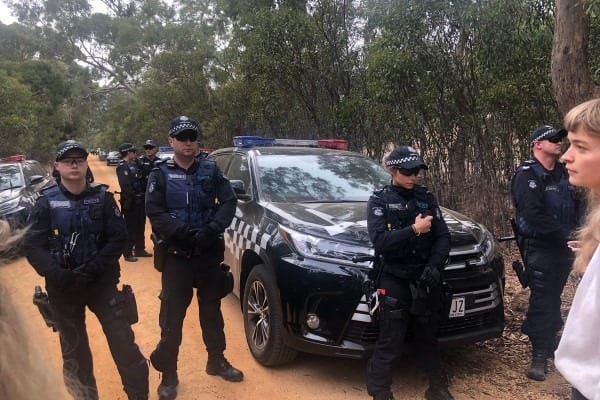A blockade to protect this sacred cultural heritage has been set up to stop the planned removal of the trees.
On Tuesday SBS & NITV reported that a heavy police presence was blocking access to the trees, but that at some point in the afternoon police stood down. They are likely to return on Wednesday.
A written statement issued by Djabwurrung Elder Aunty Sandra Onus said: “We are calling on the Australian government to stop this destruction. We need everyone to come down.”
A group of Melbourne women have started a petition asking the Victorian Government to halt the work immediately which has gathered 68,000 signatures.
Dr Neela Janakiramanan is one woman who has signed on and is urging the Premier Daniel Andrews to intervene. Here, she explains why.
On a dark night in 2012, I kissed my sleeping toddler good bye and went out into the night to give birth to my second child, in a hospital I had chosen because I knew I would be safe there. I did the same again, kissing my sleeping children good bye, to give birth to my third baby in 2016.
I found each of my deliveries to be highly emotional, not just because they delivered my beautiful children into my arms, but because I held the weight of humanity close in those dark hours.
I thought of my grandmother – who gave birth to many children on a dirt floor. I thought of the women around the world who were in love with the babies in their wombs just like me, but were delivering without facilities or medical care but, often, surrounded by women who love them, and usually in places where they feel safe at an immensely vulnerable time.
Birthing is about more than a family, ultimately it is about the continuation of the human race, and so it is no surprise that birthing traditions are among the most important in any culture.
In the western districts of Victoria, there stand some immense trees, some 800 years old. These trees are in Djap Wurring Country, and part of the ancient song lines of the Djap Wurrung people. Within the hollows of these ancient and sacred trees, dozens of generations of women have given birth to their babies.
Many, like me, no doubt kissed their existing children good bye, and went to these places accompanied by their family and birth attendants. And like us, they laboured and bore the next generation.
The archaeological evidence in this area is clear, even for those who might choose not to believe the stories of the Djap Wurrung. Many artefacts have been found locally, which point to a civilisation that harks back tens of thousands of years. While it is an absolute fallacy to judge the sophistication of a culture by European standards, even by those European standards, the Djap Wurrung built permanent houses, farmed and trapped eels, and undertook agricultural pursuits in ways which even early European explorers identified. And like people around the world, they loved and bore children.
I can think of little more important to the preservation of culture and connection to land than the places where women have birthed. And I can think of nothing more important to the ongoing health of Indigenous women today than protecting these traditional places, even if this is no longer where women go to birth.
Because, just as I, in the depths of my labour, thought back to those dirt floors and villages where my ancestors gave birth; just as I, in the throes of painful labour, took heart from the fact that if they had done it, then I could do it too – these places must exist for Indigenous people to visit, both physically and mentally.
These trees have absorbed the blood of labouring women, and it is said that more than 10,000 babies were born in its hollow. The trees are no longer just trees, but a living commemoration of life and history, witness to the unbroken line of humans who lived here before European colonisation.
Despite the clear importance of these historic sites, they are in the path of a proposed road – and today, VicRoads plan to raze these trees to the ground in order to build a road that will save three minutes of travel time.
The western districts of Victoria are full of places of significant historic value. The mountains of Gariwerd (the Grampians) have ancient rock paintings on hidden walls; signs of colonisation such as gold fields and buildings scatter the terrain; and solemn Avenues of Honour carry us into many of the rural towns, planted on the hope and despair of young women awaiting news from the Second Boer War and World War 1.
History is an integral part of our humanity. It connects us to the past, to those who brought us here and to this point in time, and it grounds us in our place. Stories, songs, and places must be protected if we are to keep our humanity.
Most of us would rightly protest if there was a plan to remove an Avenue of Honour in order to widen a road. Even if half the town had agreed to remove an Avenue of Honour, we would respect the wishes of the other half, and indeed the question would never have been raised at all. No-one would ask a town to sacrifice their Avenue of Honour for a new road.
Remembering those who have died in war is important – but so too is women’s labour. We must protest the sacrifice of these ancient trees, because they are of immense cultural significance to the Djab Wurrung people, but also because they are and should be of immense cultural importance to all Australians. There is no greater commonality between us than being born, and we must protect those traditions and artefacts that remind us of this fundamental part of being human.
Add your name to the petition here.



